|
One of UNESCO’s geologist experts remarked: “I have to admit Yuntaishan World Geopark is a unique and incomparable geopark. It impresses me as a symphony of Beethoven, the symphony of mountains and waterscapes.”
Overview
Located at Jiaozuo City, Henan Province, the 556 km2 Yuntaishan World Geopark distinguishes itself mainly by the rifting structure, hydrodynamic interactions, and“Yuntai Geomorphology” characterized by the combination of peak clusters, deep winding valleys, steep cliffs and waterscapes shaped by neotectonic movement and weathering. Yuntai Geomorphology, the typical relics of neotectonic movement, is a new member of Chinese geological landforms. Complemented by cultural sites and natural landscape, it is a comprehensive geopark embracing extremely high aesthetic and scientific value. Its territory is divided into five scenic areas: Mt Yuntaishan Scenic Area, Mt Shennongshan Scenic Area , Qinglong Valley Scenic Area , Fenglin Valley Scenic Area and Qingtian River Scenic Area and ten famous scenic sites.
Located in the stable plate in north China, Yuntaishan World Geopark, a place where the magnificent North flavor blends with the delicate beauty of South, developed a serial of complete and representative platform deposit landforms which preserve ocean relics of Mesoproterozoic Era to the Paleozoic Era (570million to 245million years ago) and especially the epicontinental sea enviroment’s deoposit relics very well. In this wonderland, detrital zircon is also found, which is about3.4 billion years old and worthy of scientific research. It also boasts special plantation and the highest altitude macaque protection zone in China.
In 2004, Yuntaishan was ratified as the world geopark by UNESCO in Paris as the Top Three Chinese Geopark and Top Five Wold Geopark in the world. Not long ago, Yuntaishan signed a Sister Park Arrangement with Songshan World Geopark, Wudalianchi World Geopark, Wangwushan-Daimeishan World Geopark in China, Langkawi Geopark in Malaysia and Grand Canyon National Park in America.
Features of Yuntaishan World Geopark
Mountains and waterscapes are Yuntaishan World Geopark’s two features. A number of 36 mountains and 20 natural caves, together with waterscapes include rivers, waterfalls and pools, making Yuntaishan World Geopark renowned worldwide. Ascending the 1304 meters high Zhuyu Peak, the main peak of this geopark, one can overlook Mt Taihangshan ranges extend all the way to horizon in the north and Huaichuan Plain as well yellow river in the south. Numerous springs, waterfalls and pools embedded into the green forest along the bizarre rocks densely, among them, the 314 meters long Yuntaishan waterfall is the longest in China, the second longest in Asia.
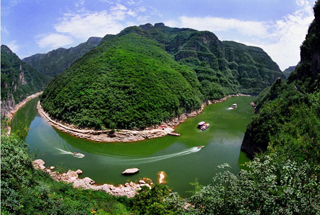 |
 |
|
Whale Bay |
Waterfalls |
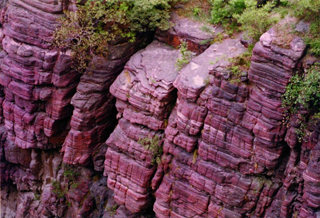 |
 |
|
Bedset Structure |
Buddha Ear Pool(佛耳湖) |
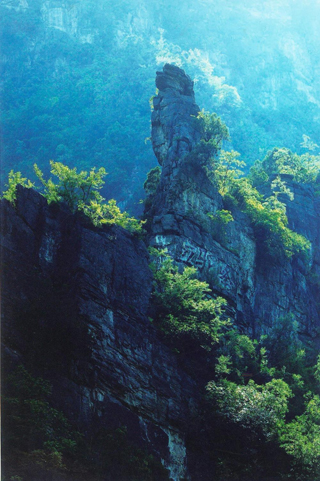 |
 |
|
Camel Peak(立驼峰) |
The Natural Great Wall (龙脊长城) |
Ten Scenic Sites of Yuntaishan World Geopark
1. Macaque Valley(猕猴谷)
After Yuntaishan was ratified as national macaque protection zone in 1998, it homes large quantities of wild macaques. Taihang macaque is under the national second level protection. Dwelling in the highest altitude in North, these macaques adapt to the cold and steep mountains environment successfully and evolve into the most advanced specy of its kind. They have handsome body, long furs, shot tails, good at jumping and climbing, agile and clever, thus if of high aesthetic and scientific study value. They usually live in communities formed by about one hundred members, ruled by a king and protected by the guard macaques. They hunt for food in daytime and sleep on the cliffs. Free macaque shows are available here, 6 times per day. It costs about one hour to tour around this site.
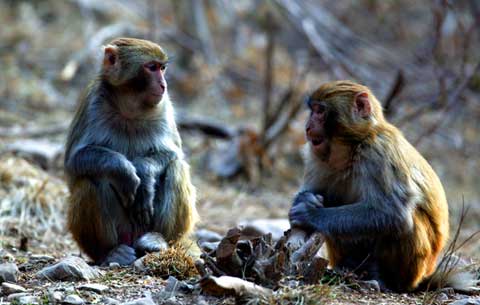 |
|
Taihang Macaques |
2. Qinglong Valley(青龙峡)
Famed as Number One Grand Valley in Yuntaishan World Geopark, the 108 km2 Qinglong Valley has 7 scenic districts which compromising over 100 scenic sites. It is a gallery composed of mountains, cliffs, valleys, waterfalls, pools, streams and natural caves. The 1323 meters high Qinglong Peak is the highest point is this area.
Qinglong Valley is 7.5km long, boasting numerous springs, waterfalls and streams of the most diversified sceneries. Huanglong Cave( Yellow Dragon Cave黄龙洞) is a Karst Cave, it is 10meters in height, 6meters in width and 50 meters in depth. You can see many lotus petal-shaped pools inside.
Ningcui Spring(凝翠泉): For thousands of years, this spring never cease to spout waters, and this spring is so crystal, just like a jade set in this area. Near the mouth of this spring stands a rock covered with moss. Cable cars are available in this area, which lasts 14 minutes.
3. Hongshi Xia (Red Stone Valley,红石峡)
The 190 km2 long and 68 meters’ deep Hongshi Valley(Red Stone Valley, 红石峡) is the essential part of Yuntaishan World Geopark. It shelters the most exquisite and marvelous sceneries inside and well deserves the name as the “bonsai valley”. Consisting of 11 scenic sites, this 1500 meters long valley takes about one and half hour to tour around.
Hongshi Valley’s earth stratum is divided into three parts from upper to lower part: limestone of Ordovician Period (400million years ago), limestone of Cambrian Period (470million to 510 million years ago) and purple Quartz sandstone formed one billion to 1.4 billion years ago. In Bailong Pool(白龙潭), the 3.4 billion years’ old Zircon was founded, which is the most ancient rocks discovered in the world. Besides, water wave stones and turtle back stones are found in here also.
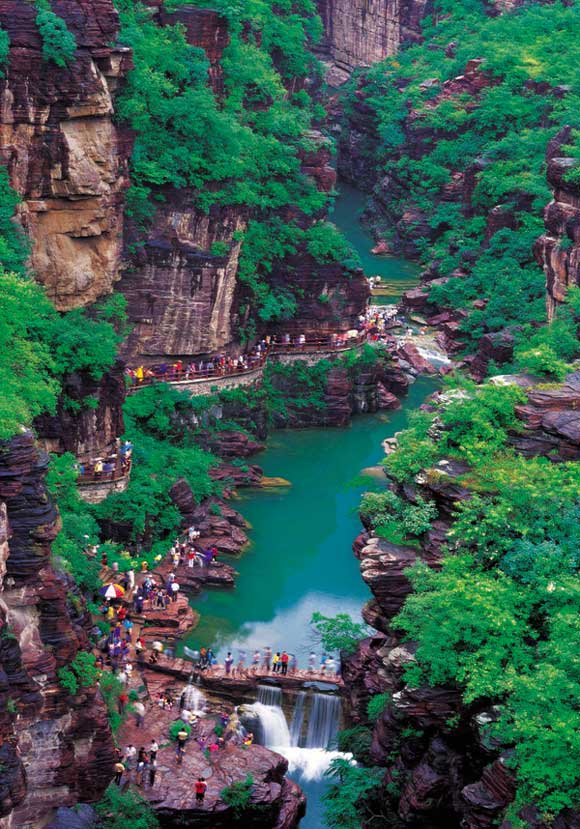 |
|
Canglong Valley(苍龙涧) in Hongshi Xia (Red Stone Valley,红石峡) |
Sixteen Highlights of Hongshi Valley
The geological relics from 1.4 billion years ago is eye-dazzling, which is famed as the “miniature landscape of mountains and waterfalls, and the amplified bonsai of high aesthetic value”
The Karst landform characterized by red steep cliffs and crooked valleys is a rare seen spectacle in North China.
Bailong Pool (White Dragon Pool,白龙瀑)
It has three layers and covers a length of over 60 meters, which looks like a flying white dragon, thus is given this name.
Heilong Cave( Black Dragon Cave,黑龙洞)
This 30 meters’ long cave is crooked and cool, decorated with steep cliffs and accompanied by the murmuring streams. Mysterious and enchanting it is, you can have a lot of fun here.
One Strip of Sky(一线天)
In a site where sky is blocked by precipitous cliffs decorated with abrupt waterfalls, you will be overwhelmed by the stunning wonder of nature.
Huanglong Pool( Yellow Dragon Pool,黄龙潭)
Streches 20 to 30 meters in width, Huanglong Pool features scenery varies with water depth from deep blue to light blue and to transparent. It is blessed with large quantities of bizarre stones.
Kissing Stone(相吻石)
Two red stones emerge from the water, looking like lovers kissing each other.
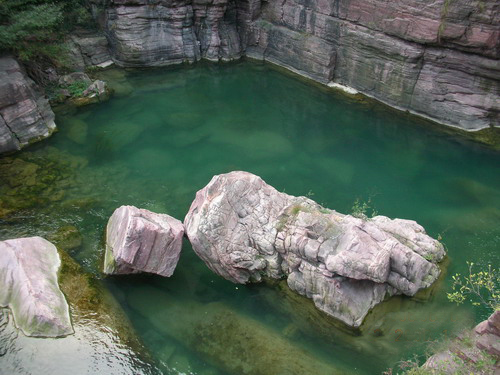 |
|
Kissing stone |
Xiaoyao Stone ( Happy Stone, 逍遥石)
It measures over 2 meters in height, 3 meters in length and 1 meter in width, half aloof and half submerged in water, boasting flowing lines and beautiful patterns, which is the masterpiece of nature.
Heilong Pool( Black Dragon Pool,黑龙潭)
Eed Karst landform mountains around Heilong Pool cast reflections on its crystal water surface, which is a very enticing scene. One can talk a walk around or tour it by boat.
Stalactites
The palette is composed of white stalactites and red quartzite here, which is a visual feast.
Dangling Stone(悬石)
Trapped between two cliffs, this rock seems is falling down.
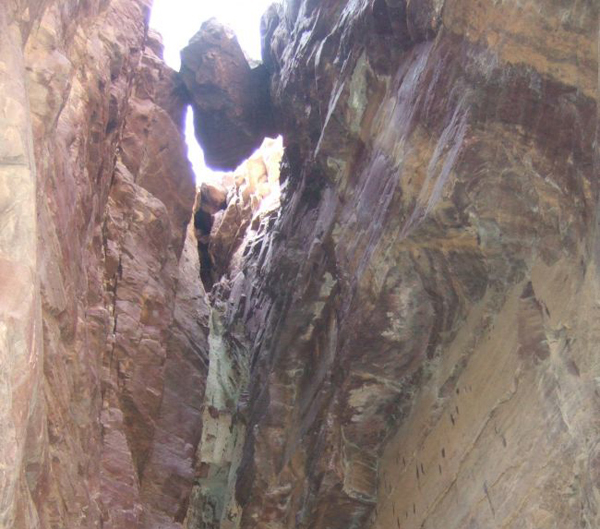 |
|
Dangling Stone(悬石) |
Huanglong Waterfall( Yellow Dragon Waterfall,黄龙瀑)
This waterfall jumps from the mountain top abrupt, splashing and thundering, which composes a giant water sculpture.
Natural fresco
Springs flow along the cliffs and sprays water drops which spackle under sunshine, against the background of vibrant green moss, forming a unique natural fresco.
Fairy Scattering Petals Waterfall
Two waterfalls in south and north respectively echo each other, their splashes look like broken crystals, which is pleasing to the eye.
Canglong Valley(苍龙涧)
Canglong Valley is a narrow strip valley flanked by towering mountains on both sides.
Finally, Hongshi Valley Scenic area combines the beauty of delicacy streams, tranquil valleys, imposing mountains and precipitous cliffs, thus is famed as Baosai Valley.
4. Zifang Lake(子房湖)
Zifang Lake is 4000meters long, and 65meters in the deepest part. In June, 2002, Craspedacusta was found here, this sensational event shocked the whole world. Craspedacusta, one of the most primitive species on earth, which can be traced to 550million years ago. it looks like peach peatals, thus is named Peach Blossom Craspedacusta in Chinese. It is extremely particular about water condition, thus we can conclude the environment in Zifang Lake is very good. Together with panda and wild horse, Craspedacusta are enlisted as national endangered species.
5. Zhuyu Peak(茱萸峰)
Zhuyu Peak, derives its name from one line of Wang Wei’s poetry, is the holly place for scholars as well as monks. Asending to Zhuyu Peak, you can have a gorgeous view. The over one thousand years’ old Rare trees such as Taxus(红豆杉) and Acer mono(五角枫) can be found here.
6. Tanpu Valley( Pool Waterfall Valley,潭瀑峡), the representative valley in Yuntaishan World Geopark
Dozens of waterfalls compete each other in beauty here, such as Lover Waterfall with whispering sound the waterfall covered a cave like curtain and the Y-shaped waterfall. Scenic sites here include Dragon Phonex Wall and Butterfly stone pool. Besides, the Forever Young Spring extends a distance of over 50 km is the precious mineral water. Furthermore, the U-shaped cliffs formed by the joint forces of underground water as well as surface water over the past 2.6 million years. Surrounded by cliffs on three sides, this morphology with one open side, small mouth and big belly, which looks like a pot, is also called Pot Vally morphology. Tanbu Valley is over 2000 meters long, and takes one and half an hour to tour.
7. Quanbu Valley(泉瀑峡)
This Fairyland is 3000 meters long, constituted by towering mountains, rush waterfalls and springs pop up from underground against the streams. It was formed 540 million to 490 million years ago. Over the past 23million years, the The 314 meters long Yuntai waterfall, the highest waterfall in China, sits at the end of Quanpu Valley. Under the joint forces of water erosion, uplifting and collapse, the over 3000 meters long and 500 meters deapth Quanbu Valley came into its own. It takes about two and half an hour to tour around this site.
 |
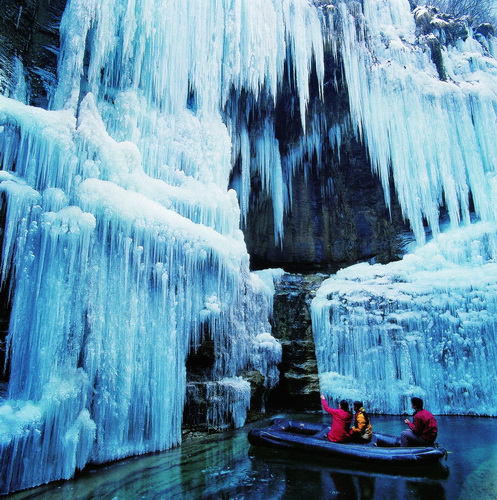 |
|
Waterfall |
Frozen Waterfall |
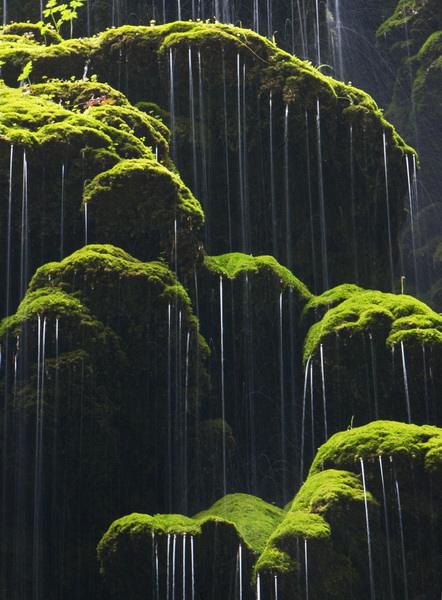 |
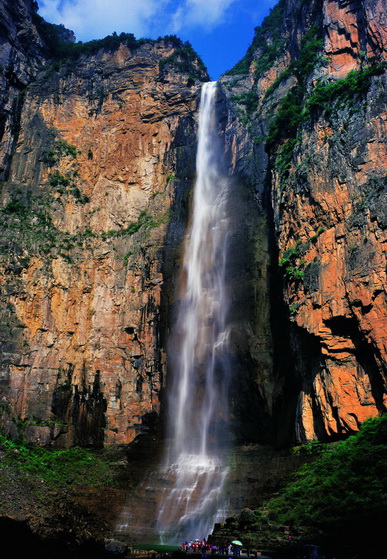 |
|
Water Flows Along the Cliff |
Yuntai Waterfall, the Longest in China |
8. Fenglin Valley(峰林峡)
Fenglin Valley has deep valleys and grotesques peaks. It shelters a lake which mirrors the enchanting sceneries around. 平湖
9. Baijia Rock(百家岩)
This site is not open yet. It mainly boasts rich cultural context. Seven Elites seclude among the Bamboo Forest(竹林七贤) once dwelled at this site for 20 years, leaving many cultural relics.
10. Wanshan Temple(万善寺)
Wanshan Temple was built in Ming Dynasty(), it was named by Emperor Shenzong. The past four hundred years witnessed its rehabilitation and expansion. It costs half an hour to appreciate this site.
11. Diecai Cave(叠彩洞)
It was built from 1977 to 1987, and many people die in the accident when build it. Diecai Cave is 4831 meters long, with relative height of 912 meters, all the turns inside of its 19 caves are 180 degree. Every 100 meters, the altitude will rise 5 meters. It is really a thrilling experience to go through this cave by car. And it takes 20 to 30 minutes to pass through Diecai Cave.
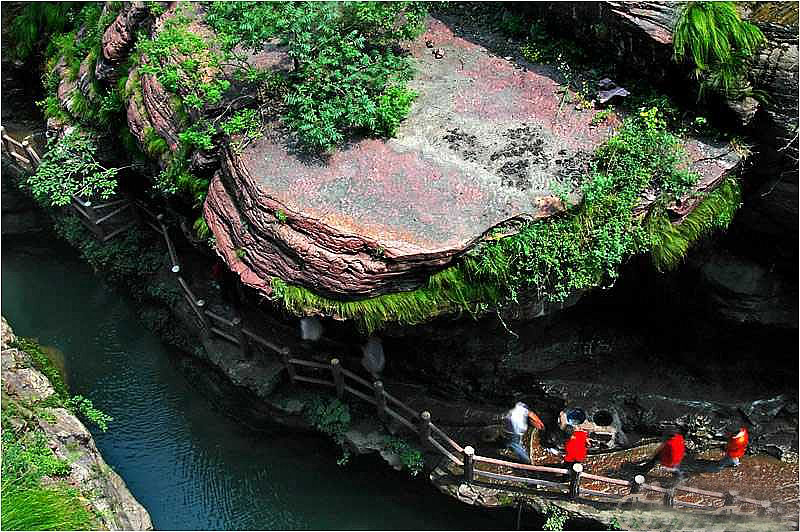 |
|
Diecai Cave(叠彩洞) |
Travel Tips
Avoid Labor Holiday in May and National Holiday in October, for it will be crowded here.
What to See in Four Seasons:
In Spring, the average temperature is 16℃, once can enjoy the flower blossoms;In Summer, the average temperature is 24℃, it is ideal time to appreciate virgin forest , waterfalls and springs. While Autumn with average temperature of 18℃, is the best season to appreciate autumn leaves and the highest waterfall in China: Yuntai Waterfall. In winter, the average temperature is 2℃, you can enjoy the frozen waterfall and snow scenery here.
Local Specialties
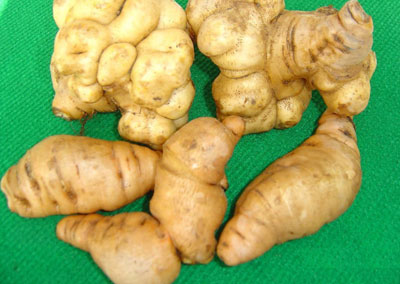 |
 |
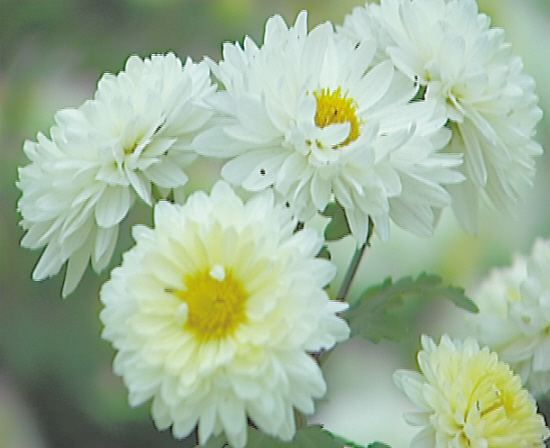 |
|
Dihuang(淮地黄) |
Yam(淮山药) |
Chrysanthemum(淮菊) |
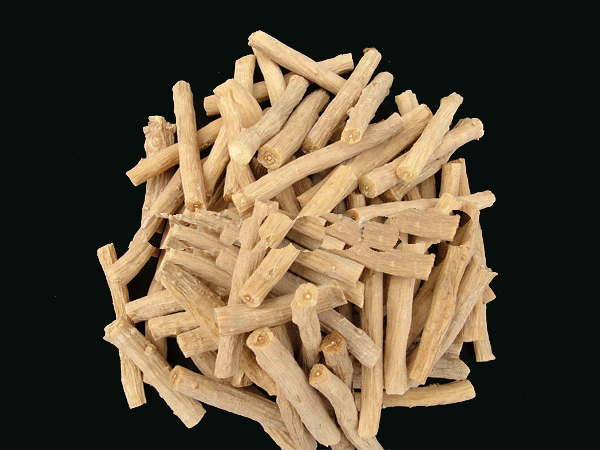 |
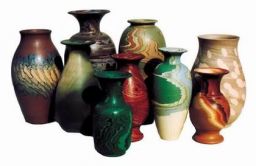 |
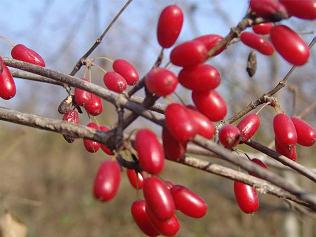 |
|
Achyranthes (淮牛膝) |
Ceramics |
Wild Fruit | |



